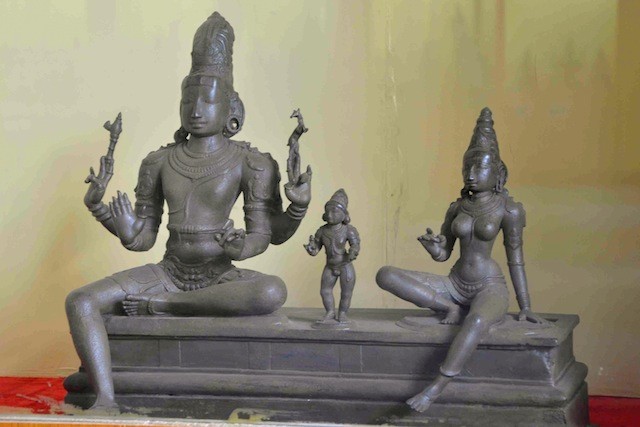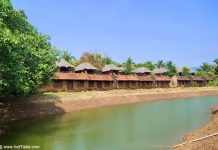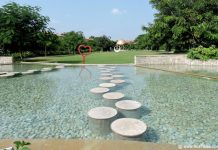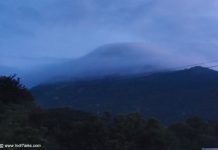The Chola temple trail cannot be complete without the mention of the Chola Bronze Statues. A defining art form of the region and the times of Cholas.

Chola Bronzes
I saw Chola Bronzes at two places during this trip. One was at the Museum of Art in Maratha Palace, Thanjavur. And the second was at Egmore Museum in Chennai which has some of the biggest and the best pieces of Chola metal craft. At Chennai, there is a bit of documentation too that explains to you the popular forms of deities carved in Bronze. The galleries are in fact organized by deities, so there is one each for Shiva, Parvati, Vishnu, Ganesh, et al.
Chola Bronze Statues Making
A video at the entrance explains the process of making these idols using the lost wax method. And the importance of Patina is the layer of tarnish that gives the sheen to the metal over a period of time and the one that makes the antique pieces valuable. The method of lost wax is mentioned in ancient texts. It is a living tradition that is still practiced in the same fashion. Smaller idols are made of a solid cast while the larger ones are made in a hollow cast to keep them light. There are two primary metals used: Bronze which is an alloy of Copper and Tin and Panchola which comes from five metals: Copper, Tin, Gold, Silver, and Lead.
Understanding the Chola Bronze Statues

The origin of Bronze images lies in the urge to take out the Gods in palanquins from the temples. Since this was not possible with huge stone idols, smaller idols carved in metal were light and easy to be taken around. And came to be known as Utsav murtis or festival idols. Rules of iconography here followed for metal images are just like the stone ones. Then it became a fashion for the rich and famous to donate bronze idols to the temples.

Nataraja in Bronze Statues
Nataraja is the most popular image in Chola Bronzes. This is the dancing Shiva, the presiding deity of the Chola dynasty. In the Chennai museum, you see some of the most beautiful Nataraja idols. You can get mesmerized looking at them, but the fact that the museum has no facility for you to sit and admire them. After Nataraja, the next most popular image is Somaskanda where Shiva is depicted sitting with his consort Uma and his son Skanda dancing between them on a platform. Other images of Shiva highlight some aspects of his personality like Chandrashekhar highlights the moon on his head and Gangadhara the Ganga coming out of his hair.
Popular Shiva Parvati Avatars
Ardhanarishwar with half Shiva and half Shakti is another popular image, here you see the master craftsmanship when the limbs of the two parts are carved accordingly, the female part being smaller and delicate. Parvati is also carved in her various avatars like Maheshwari, Durga, Kali, etc. Her most popular avatar remains Mahishasurmardini – the one who slays the demon Mahisha. In one idol I found her wearing a short garment on one leg and a long one on the other, something that I have not seen elsewhere, a designer idol probably.
Ganesh
Ganesh, Murugan, and Nandi complete the Shiva family. Ganesha is depicted with a very long upper body and short legs. Vishnu also had a few idols. One that I found most amusing was in his Varaha avatar with a Devi on his lap as he stands on a raised leg. There is a huge image of Sudarshan chakra that again looked quite unique. Most idols stood mounted on the solid metal pedestal that had solid hooks as if to pull the idols using ropes or to tie them up with something.

The general height of the women shown is substantially less than men in these bronzes and they are far more slender. The noses are sharp and head ornamentation is elaborate. Both sexes are depicted without an upper-body garment. The lower garments have quite a bit of experimentation. What stands out is the harmony and rhythm that oozes out of the proportionately carved figures. They have gathered a color of their own over a period of time. Enter these galleries like a Rasik and enjoy the beauty of these pieces that only increases with time.
You can buy books on the museum artifacts from the museum shop if the staff obliges you.
A must-see museum if you are in Chennai.
Watch these wonderful lectures on Chola Bronzes by Dr. Vidya Dehejia.
Recommend you to read the following Chola Temple Trail in Tamil Nadu.
Chidambaram beyond its Iconic Nataraja Temple
Largest living temple in Srirangam, Trichy














Nice bronze works.
Your series of posts shed a wonderful light over the history of Tamil Nadu.. Thanks for writing them..
amazing!!
interesting & informative…
Great informative post with amazing sculpture.
thanks for sharing
Your articals are very informative and interesting.Please publish all articals in a Book form.
[…] sa collection de bronzes Cholas. Il s’agit de la deuxième plus belle collection après celle du musée de Chennai. Si la muséographie et la conservation font pitié, les pièces à la cire perdue sont d’une […]